Minimum Time Between Shifts: Latest Laws and Requirements in 2026
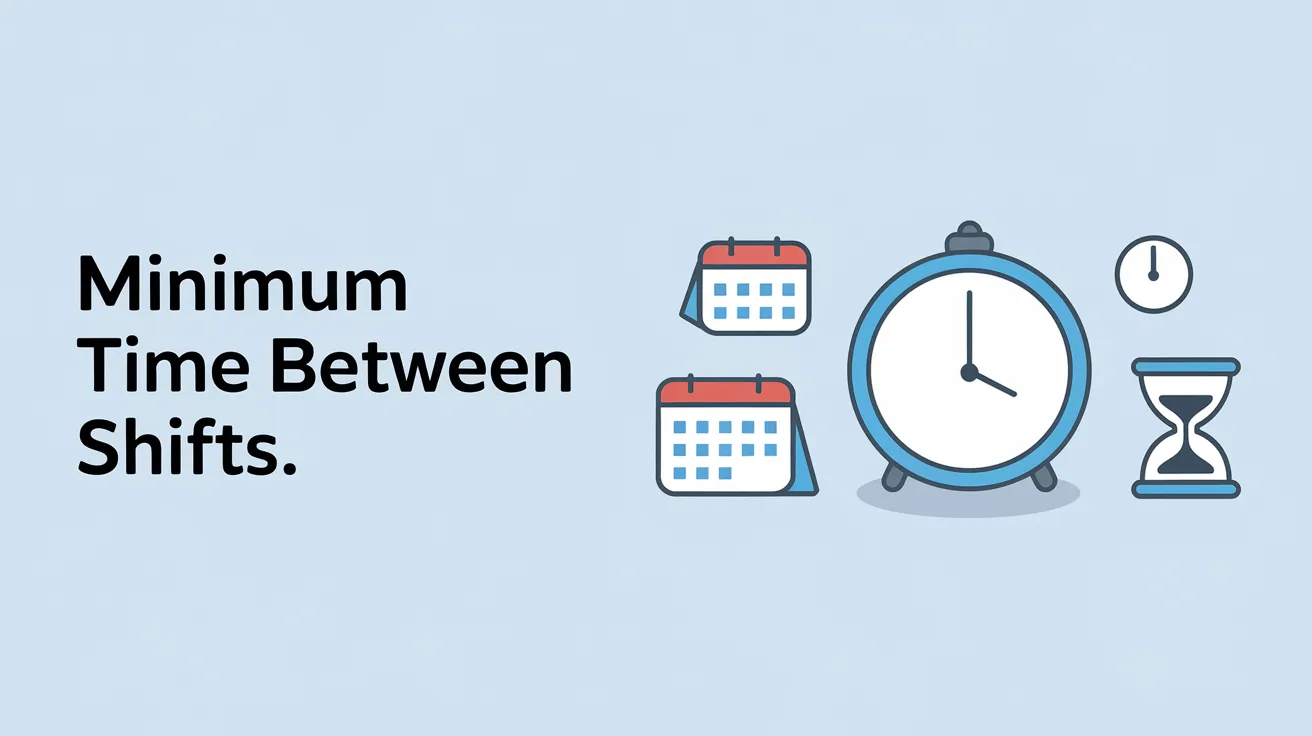
Maddy, a nurse in New York, works from 8 AM to 1 PM. Then, she has a few hours off before she has to go back to work at 3 PM. She works until 8 PM.
Well, as you can see it’s a long and hard shift for an employee to work. That's where the minimum time between shifts can help. It balances shifts and makes sure employees get enough rest.
So, how much time is actually enough? Well, I’ll share all the details, including —
- Legal requirements for shift breaks
- Industry-specific standards
- Tips for creating fair schedules
- Common challenges for employees and employers
Let’s help you optimize your work schedule and increase productivity.
What is the Minimum Time Between Shifts?
The minimum time between shifts refers to how long an employee must rest between finishing one shift and starting another. And it can impact the overall calculation of how many work hours in a year.
For workers 18 years and older, the law requires at least 11 continuous hours of rest between shifts. For younger workers aged 16 and 17, the minimum is 12 hours. These rules apply whether the worker has a full-time or zero-hours contract.
Of course, there are exceptions in certain jobs! Especially if someone has opted out of the 48-hour workweek.
In the U.S., laws like the Fair Labor Standards Act (FLSA) cover areas like overtime and wages. However, they don’t specify rest periods between shifts.
But even without those specifics, employers must plan shifts that allow for proper rest.
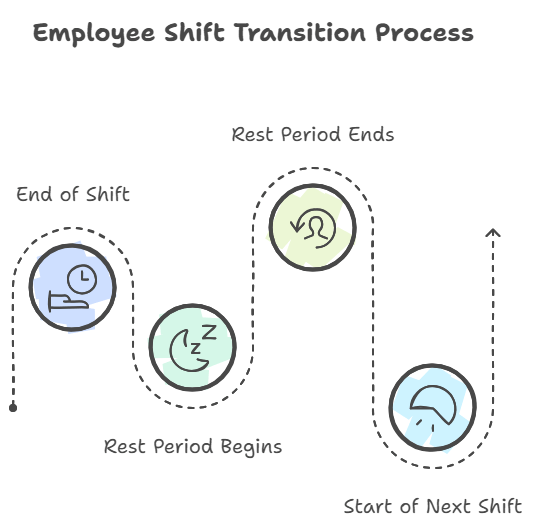
What are the Different Types of Breaks Between Shifts?
There are various types of breaks between shifts, each serving a different purpose. These can include rest breaks during work hours, meal breaks, or longer periods off between shifts.
So, let’s get deeper into those different periods.
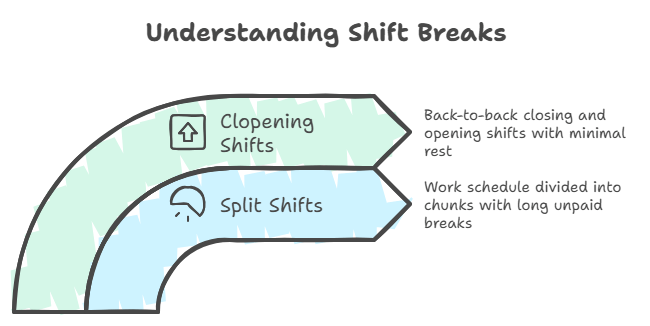
Split Shifts
A split shift is a work schedule that’s broken up into two or more chunks, with a longer break in between. This break is much more than your typical lunch or quick rest. Plus, it’s unpaid and has to be at least 2 hours long.
Instead of just taking a quick lunch break, you’ll end up with a longer pause in your day.
Here, managers can use a time tracker to see when people start and finish their shifts. It helps them track time accurately and efficiently.
Split Shift Example —
In busy resort towns, restaurants often operate split shifts to handle peak meal times. A server might work from 8:00 a.m. to 12:00 p.m. to cover breakfast and brunch, then take a 5-hour break.
They return at 5:00 p.m. to work until 9:00 p.m. for the dinner rush. The restaurant uses a split shift schedule to have enough workers during busy times. Plus, it avoids having too many workers during slow times.
Remember, split shift laws differ across states, depending on several factors —
- Whether an employee is full-time or part-time
- The total hours promised or expected for their role
- If they are paid a salary or an hourly wage
- Whether the employee is under 18
Further Read: Work Schedule Types
Split Shift Pay System
If an employee earns minimum wage and works a split shift, they’re usually entitled to a " split shift premium". It’s equal to an extra hour of pay at the minimum wage rate.
Even if you earn more than the minimum wage, you might still be eligible for this extra pay. However, the amount may be a bit less based on what you make.
Example:
Ben, a minimum-wage server, works split shifts from 10 AM to 2 PM and 5 PM to 9 PM. Due to his break exceeding one hour, he qualifies for a split shift premium.
So, he’ll get an additional hour of pay at the minimum wage rate, ensuring fair compensation for his divided work schedule.
Plus, you usually don't qualify for this additional pay if you live at your workplace—like on-site employees. It’s a common exception in these cases.
Colpening or Shifts Scheduled Close Together on Separate Days
A clopening shift is when you’re scheduled to close up at work one night, then have to come back early the next morning to open. The term “clopening” is a mash-up of "closing" and "opening."
You barely get any time to rest in between shifts. Sometimes just 4 hours or so to catch your breath before you’re back on the job.
I’ve noticed that clopening shifts are pretty common in places with long hours or not enough staff. For instance, restaurants, retail shops, bars, or convenience stores.
They tend to pop up more during busy seasons or when the business needs extra coverage to stay open.
The worst part? There’s hardly any time to recover.
You finish a late-night shift and head home with only a few hours to sleep and return in the morning. It can take a toll on you.
Example of a Clopening Shift:
- Opening shift: 6:00 a.m. – 12:00 p.m.
- Closing shift: 11:00 p.m. – 2:00 a.m.
A schedule like this can quickly wear you down, leaving you feeling tired, stressed, and even burned out. Without enough time to rest, it's hard to stay energetic.
The CDC says adults require about 7 hours of sleep every night. But if you’re only grabbing a short nap before heading back to work, it won’t be long before it starts affecting you.
Legal Regulations for Minimum Time Between Shifts
There are federal laws about lunch breaks. But most rules about time between shifts are made by the states.
So, let's see what each state says about the minimum time you need between shifts.
California
In California, there’s no strict rule about how much time should pass between shifts. If you work for 5 hours, you’ll likely be eligible for a 30-minute break.
However, if you have to work two shifts on the same day and there's more than an hour between them, you'll get extra pay for each extra hour you wait.
On the other hand, if you earn more than the minimum wage, this minimum time between shifts California rules might not apply to you.
Example for Hospitality Workers
Miguel is a waiter in California. He works from 8 AM to 1 PM and then from 5 PM to 10 PM. He has a 4-hour break between shifts, but he only gets paid minimum wage.
Legal Regulation:
California law says that workers who have split shifts must get extra pay. This extra pay is equal to one hour of minimum wage for each day they work a split shift.
Oregon
The minimum time between shifts in Oregon allows you to get at least 8 hours of rest between your shifts. So, you have the right to refuse those tiring "clopening" shifts.
However, if you do agree to work shifts with less than 8 hours in between, you’ll be paid double for those hours. This rule ensures you're fairly compensated for the extra strain on your schedule.
Here, you can easily manage the time if you know how to track employee hours accurately.
Example for Hospitality Workers
Jake works at a coffee shop in Oregon. He finishes his evening shift at 10 PM and is scheduled to open the shop at 5 AM the next morning. So, he gets only 7 hours of rest.
Because he needs the extra hours, Jake agrees to work the shift despite the limited rest time.
Legal Regulation:
Jake, according to Oregon's labor law, should have at least 8 hours of rest between shifts. By agreeing to work with only 7 hours of rest, he is entitled to double pay for the entire 5 AM to 1 PM shift. That’s because he didn't get enough rest.
New York
In New York, if your break lasts longer than an hour, you must be paid at least the minimum wage for that time.
Unlike in California, this rule also applies if you work more than 10 hours in a day. Even with a lunch break for 30 minutes, you’re still paid for the entire shift if it goes over 10 hours.
Example for Retail Workers
Rachel works at a department store in New York. Her shift starts at 9 AM and ends at 7:30 PM, totaling 10.5 hours, including a 30-minute lunch break.
Because her shift exceeds 10 hours, she is concerned about whether she will be compensated for her entire work period.
Legal Regulation:
In New York, if you work more than 10 hours a day, you must get paid for your entire shift, even if you take a break.
Short breaks don't affect your pay. But if your break is longer than an hour, you must be paid for that time at least minimum wage.
Florida
In Florida, if you're doing manual labor, a normal workday is considered 10 hours. If your employer wants you to work beyond that, they must pay you extra.
The only time this changes is if you and your employer agree on a different schedule in writing. That way, you're both on the same page, and there are no surprises about your work hours.
Example for Construction Workers
Tom works in construction in Florida. He usually works 10 hours a day. His boss asked him to work 12 hours on a project.
This is longer than the usual 10-hour workday in Florida. So, Tom and his boss agreed to this in writing.
Legal Regulation:
In Florida, manual labor workdays are capped at 10 hours. Any work beyond this must be compensated with extra pay unless an alternative schedule is agreed upon in writing by both the employee and employer.
Hawaii
You can’t be scheduled to work more than 14 hours in 24 hours in Hawaii. I believe this rule helps keep shifts from being too exhausting.
But you might have to work beyond that limit if there's an emergency. When that happens, overtime laws kick in, and you should still get paid extra for those long hours.
Example for Healthcare Workers
Keanu is a nurse working at a hospital in Hawaii. Typically, his shifts are capped at 14 hours per 24-hour period to ensure adequate rest.
Keanu's boss asked him to work extra hours because of a storm. Many patients were hurt, so Keanu needed to help.
Legal Regulation:
In Hawaii, employees cannot be scheduled to work more than 14 hours in a 24-hour period. However, in emergency situations, this limit can be exceeded.
Under these circumstances, overtime laws require that employees receive additional pay for hours worked over the regular shift length.
District of Columbia
In DC, the rule is simple, If you’ve worked two shifts with more than an hour between them, you’ll get paid for an extra hour at your usual rate.
I think it’s a fair way to make sure your time is valued.
If you’re in Colorado and covered by their overtime law, things are even better. You get 1.5 times your regular pay if you work more than 12 straight hours, over 12 hours in one day, or more than 40 hours in a week.
Guess what? Your meal breaks are excluded from that count.
Example for Retail Employees
Carla works at a clothing store in the District of Columbia. She works from 9 AM to 1 PM, then takes a three-hour break.
After that, she works again from 4 PM to 8 PM. This split schedule includes a break of more than one hour between shifts.
Legal Regulation:
According to the rules in Washington D.C., if you work two jobs in one day with at least an hour break between them, you get paid an extra hour. This is to make up for the time and trouble of working two jobs.
Aside from that, these laws might only apply to certain businesses, such as:
- Hotels and restaurants
- Schools
- Charities and religious organizations
- Non-profit organizations
What are the Industry-Specific Standards for the Minimum Time Between Shifts?
Some jobs have strict rules about how much time you need between shifts. From my experience, it all depends on the industry.
And there are usually guidelines that cover things like —
- Lunch breaks, meal times, or rest periods
- How much time should pass between your shifts
- Whether your rest is long enough for proper sleep
- Required time off throughout your day, week, or even year
These rules change depending on the industry and state. That’s why you should know what applies to your specific job.
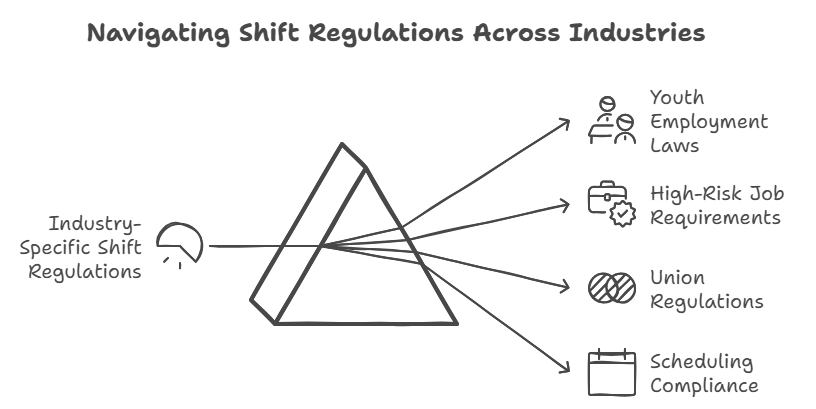
Laws for Youth Team Members
If you're a minor, you can work, but there are some important rules to follow. I’d highly suggest you to know these guidelines:
- If you're 14 or 15, you can't work more than four hours without a break. On school days, you're only allowed to work three hours, but on non-school days, you can go up to eight hours. Just remember, you can’t work more than 18 hours in a week.
- When you turn 16, there is no limit on how long you can work. But you still cannot work in jobs that the Secretary of Labor says are dangerous, like driving, roofing, etc.
High-Risk Job
In some high-risk jobs, rest periods are non-negotiable.
For example, long-haul truck drivers also have to take breaks, usually around 8 hours. That said, it can vary depending on the state.
I’ve heard from drivers how these breaks help keep them sharp on the road.
Again, if you're a pilot, you can’t fly more than 8 hours in a 24-hour stretch.
On longer flights, there’s always more than one pilot, so you can swap shifts and rest up.
Construction workers, especially those running heavy machinery, also have strict rest rules to avoid accidents from fatigue. These breaks help keep everyone safe while working with dangerous equipment.
Union Regulations
From what I’ve seen, union rules can really impact how much time you get between shifts. These rules can be very different depending on the industry.
Plus, some companies have better union agreements than others.
When putting together a work schedule, it’s vital to keep these union guidelines in mind. That way, you can avoid any headaches or issues with shift hours and ensure everything runs smoothly.
Further Read: Importance of Time Management in the Workplace.
Scheduling Compliance
Sometimes you may find it tricky to schedule when managing your team. Well, the credit goes to all the different state laws and industry rules.
Here are some key things you should always keep an eye on —
- On-call and per diem laws
- Fair Workweek guidelines that tell you when employees should get their schedules
- How many hours someone needs to work to be considered full-time
- The maximum number of hours anyone can work in a single day
What are the Challenges Faced by Employees and Employers?
Both workers and bosses have problems with managing shifts and schedules. From my experience, these problems often include:
- Ensuring people have enough rest
- Stopping people from getting too tired
- Following work laws
At the same time, they also try to keep the business running smoothly. So, here are a few challenges I’d like you to pay attention to —
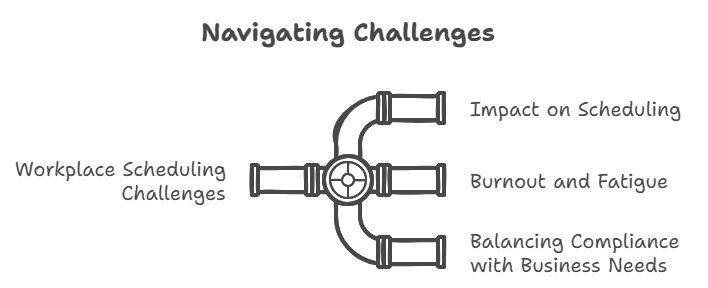
Impact on Scheduling
It's hard to make a good schedule when you have to think about different state laws and rules for each industry. That’s why employers must make sure they give workers enough time between shifts.
At the same time, workers need schedules that let them rest enough without messing up their personal lives too much.
Burnout and Fatigue
When you have to work long hours or clopening shifts, it can lead to feeling burned out and tired.
I've felt this myself! That's why more and more companies are trying out the 4-day work week. They want to see if it's good or bad. If you don't have enough time to rest between shifts,
I know from experience that it's easy to feel exhausted. And it can definitely affect how well you work and how you feel overall.
Balancing Compliance with Business Needs
Employers need to comply with labor laws regarding breaks and rest periods. However, I understand that they also have to meet the demands of the business.
In my view, knowing how to stay organized at work is absolutely vital for keeping everything running smoothly. It's tough to find a balance between doing what's legal and what's needed to run a business.
You can also try to explore different work schedules like 2-2-3, 4/10, 9/80, Flex, and Hybrid schedules to get the best out of your time planning.
Tips for Employees and Employers
I understand that balancing shift schedules can be challenging for both employees and employers. So, here are a few tips I’ve implemented and worked wonderfully.
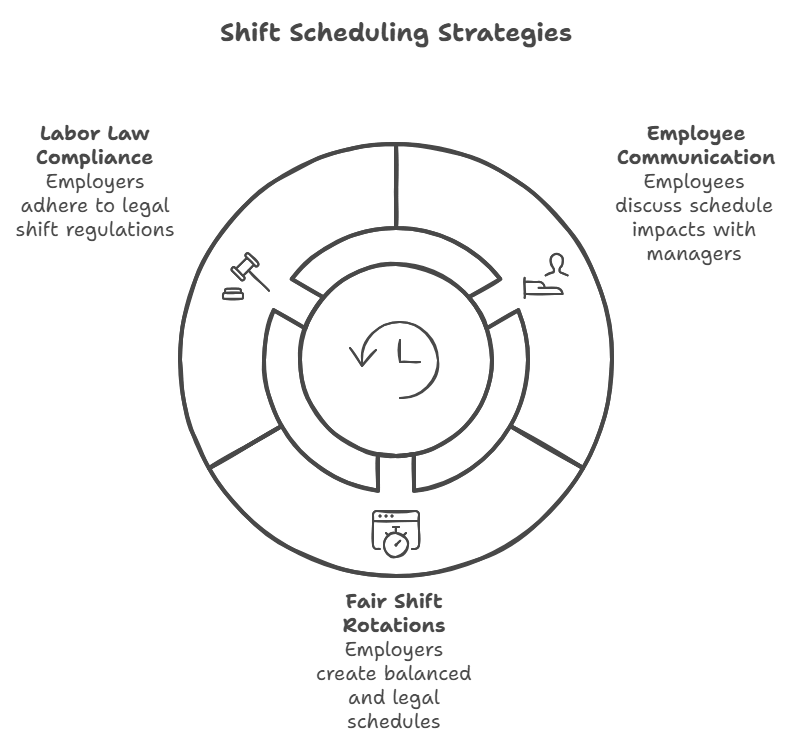
For Employees: How to communicate concerns with managers about shift schedules.
If your shift schedule is making you too tired or hard to manage your personal life, it's time to talk to your manager.
- Begin by explaining how the schedule is affecting your sleep, health, or overall performance.
- Be specific about issues like split shifts or "clopening" shifts, where there’s hardly any time to rest.
- Rather than just pointing out problems, offer some suggestions.
- You might ask for more time between shifts or a more regular schedule.
Being open and honest with your manager helps them understand what you need. This can lead to a solution that's good for both you and the company.
For Employers: Strategies for creating compliant, fair shift rotations.
Making fair shift schedules and following the law can be tough, especially with different state regulations. To avoid problems —
- Ensure your employees get enough time to rest between shifts, aiming for at least 11 hours off for adults.
- Try not to rely too much on “clopening” shifts, as they can quickly lead to tired and unmotivated staff.
- It can also help to get input from your workers about their schedules to keep them balanced.
- Stay updated on labor laws, such as overtime and split shift pay.
If you plan things well, your business can keep going, and your employees can still take breaks.
Conclusion
In brief, getting minimum time between shifts is vital for a better balance between work and personal life. Knowing your rights to rest periods can help you avoid exhaustion and burnout.
Plus, different states and industries have their own rules. However, they ensure enough rest between shifts to help you stay productive and energized. As workplaces change, there’s hope for more flexible schedules that support your well-being.
With tools like Apploye, you can easily keep track of shifts. That way, it becomes easier for you to follow the rules and keep your team working well.
FAQs
What is the shortest time between shifts?
In most U.S. industries, there’s no federal rule about minimum time between shifts. However, certain jobs, like truck drivers, require at least 8 hours of rest, while airline pilots must have 10 hours off between shifts.
Specific industries set their own regulations.
What is the longest legal shift?
There’s no federal limit on how many hours an adult can work in a single shift in the U.S. The Fair Labor Standards Act (FLSA) only mandates overtime pay for working over 40 hours a week. However, it doesn't set a cap on shift length.
How many hours is a double shift?
A double shift means working two consecutive shifts back-to-back. For example, if one shift runs from 9 AM to 3 PM and the next from 3 PM to 9 PM, working straight from 9 AM to 9 PM would be considered a double shift, covering 12 hours.
What is the ideal shift time?
An 8-hour shift is generally better than a 12-hour one. Research on circadian rhythms suggests that starting shifts after 8 AM aligns better with the body's natural clock.
